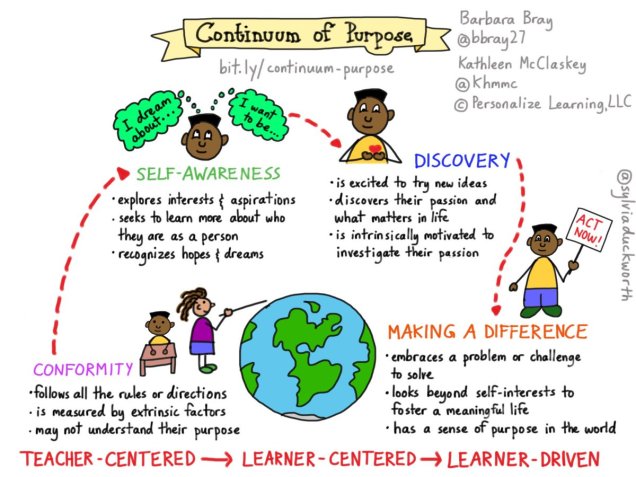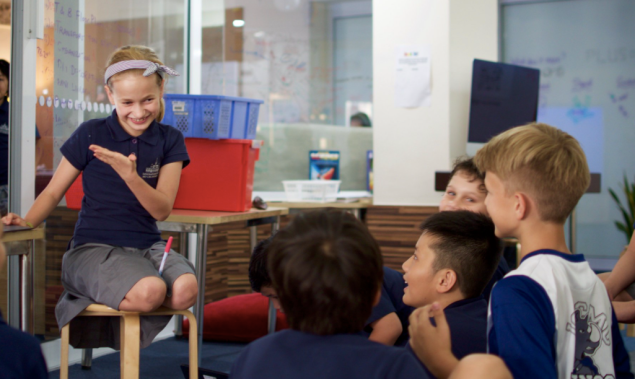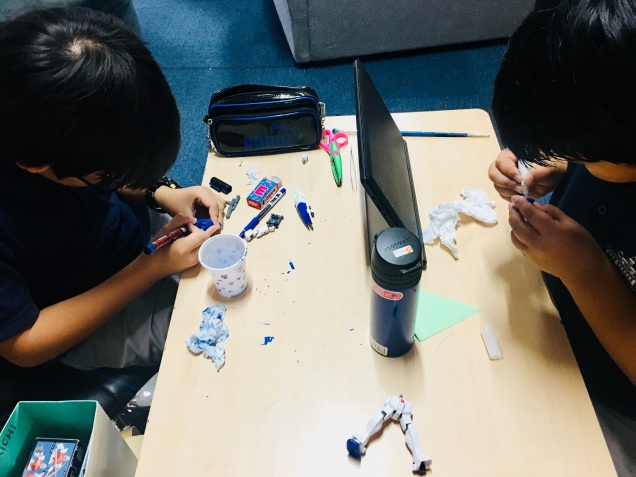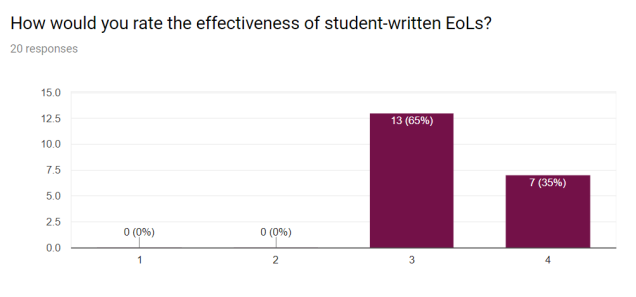Currently, our grade level has 84 different Units of Inquiry happening simultaneously – a different one for each student. All connecting to different transdisciplinary themes, exploring different key concepts, developing different ATL skills, strengthening different attitudes, developing different attributes of the Learner Profile and lasting for different lengths of time.
It is PYPx?
Nope… it’s just a “normal” week in Studio 5!
How did we get here? What was our “why”? Our “how? Our “what”? And where do we go from here? Stick with me for this lengthy blog post and I will try to capture and share our journey through supporting our students to plan, execute, and report on, their own Units of Inquiry.
Why?
So often as PYP educators, we start with the UOI and then work hard to figure out how to wrap each student around the unit we have planned. We use provocations, tuning in activities and student-generated questions to help students find “their connection” to the UOI. And although UOIs are broad and conceptual with lots of space for inquiry within, at the end of the day we are still trying to get students to find their connection to our units.
The more and more my team and I began to understand and value student agency, the more and more we began to wonder:
Why do all of our students need to be inquiring into the same UOI all at once, for the exact same length of time?
Aren’t all of these teacher-made decisions when planning a UOI pulling us away from our goal of respecting and supporting students’ agency as learners?
Do all of our students even need to be inquiring into the same TD theme at the same time?
Dissatisfied with our previous attempt to reconcile agency and teacher-planned Units of Inquiry, we decided to be risk-takers and take action. Instead of trying to wrap each student around a UOI, we decided to try and wrap a UOI around each student.
Our goal was to help students plan their own Units of Inquiry based around their own passions, interests and curiosities, while at the same time protecting and maintaining the role each of the 5 essential elements of the PYP played within a UOI.
How?
If we were going to expect our students to plan their own units based around things they were intrinsically motivated to learn about, we knew we had to empower students to understand motivation and more specifically, understand their own motivation. So with the help of Dan Pink’s research and resources we began an inquiry into motivation.

Next, we wanted to help students be able to choose something they were truly motivated to learn. We knew that jumping straight into “What’s one thing you are intrinsically motivated to learn” was unlikely to get us where we wanted to be, so instead we crafted some questions to hopefully help students uncover things in their lives that already showed evidence of intrinsic motivation.
Students filled one in about themselves:


Their parents also filled one in about their child:


Then students used both “planners” to select one “purpose”. We chose the word “purpose”… well, purposefully! We knew that eventually we wanted to have students plan their unit using a modified PYP Bubble Planner, and we wanted to keep the essence of that planner as much as possible. And since box 1, question 1 on the Bubble Planner is “What is our purpose?” we knew that eventually the student Bubble Planner would ask “What is your purpose?” Another reason we chose purpose is because we wanted to steer clear of the word passion. Earlier on in the year, our Head of School provoked our thinking with the article “7 Habits Instead of Passion” which posits that ‘follow your passion’ can be dangerous advice. Ever since then we as a team have been very careful not to de-rail our student planned UOIs by focusing on “passion”.
We also discussed the concept of purpose with students – with the help of this “continuum of purpose” compliments of @sylviaduckworth.

Knowing that this was the first time many (if not all) students had planned their own UOI around their own purpose, we knew there would be a range of the types of “purposes” that fuelled these units – many which we guessed correctly would start in the “self-awareness” and “discovery” stages.
Once students had nailed down their first “purpose” they met with a learning advisor to plan their first personalized Unit of Inquiry. Since this approach was new for my team, we all decided to use a different planner – but all of which were based off of the PYP Bubble Planner, and connected to Dan Pink’s 3 magic ingredients of motivation. As the experts on the PYP, we helped students to “wrap the PYP” around their purpose by identifying how their purpose connected to each of the 5 elements.







As can be seen from these examples, students selected their purpose, decided how long they would need to achieve their purpose, chose how best they would document their learning, what their evidence of mastery would be, and what specifically would need to be “learned about” and “developed” throughout their unit. Careful time and consideration was also given to supporting students to brainstorm resources for their learning, both within the school and beyond.
Next students were supported in creating their own timelines, tailored to the amount of time they estimated they needed to achieve their purpose.


Then students were off an running!
Along the way, students had regular check-ins with their learning advisors to discuss their progress, challenges, adjustments to timelines, needs for resources etc. We also organized an adult-database that collated teacher and parent professions, hobbies and interests and showed students how to make use of the database to contact experts connected to their purpose.

We also put together a procedure for students to organize their own field trips out into the community.

Students also received support, guidance and encouragement from their parents who were invited for “learning conversations”. Parents were brought into the fold about the “why, how and what” behind student-planned UOIs and were coached in how to stimulate conversation about their child’s learning, while showing respect for their child’s agency over their learning.




We even had students who had “virtual conversations” with their parents via Skype and FaceTime!

Most impressively though was the way students supported themselves and one another. It was not uncommon to see students curate their own learning resources and materials (microscopes, scales, glue, wood, cameras, safety glasses etc.)


And reach out to one another for advice, expertise and support.




Students were also great at knowing when they needed an adult’s help and sought out assistance, supervision or feedback – regardless of whether it was “their teacher”.


It’s also been great to see that opportunities for sharing learning have been organic, authentic, purposeful and student-initiated. Most of the time it’s the simple “you gotta see this!” or “check this out!” moments.



But occasionally there have been some bigger, more planned moments where students have “taken their learning public”.
Whether it’s asking to perform a song around the campfire during a school camping trip

(photo cred @puglifevn)
Or signing up to sell a product at our school’s weekly market

Or putting together a student-led workshop, to more formally teach other students what they have learned.

(photo cred @puglifevn)
What?
So what exactly did these student-planned UOIs explore? Anything and everything under the sun!
Robot hands and flying shoes

Digital design

Special effects movie make-up

Entomology

(photo cred @puglifevn)
Film production

Doll house construction

Mosquito repelant and anti-itch serum

Digital music mash-ups

Cooking

Photography

basketball skills

(photo cred @puglifevn)
font design

Miniature Models

A scale replica of the KL race track

Not to mention… taking care of young children, building mini arcade games, coaching swimming, writing poetry, shoe “flipping” (buying bulk at a low cost and selling individually at a profit), app development, singing covers of pop songs, shoe design, dress making, stand-up comedy and the list goes on…
Looking over this list, I can’t help but think of this quote from John Taylor Gatto:

So, where do we go from here?
Currently students are at a fork in the road, where they have the option to “pivot or persevere”. Students who have achieved their purpose or have noticed their intrinsic motivation has dropped (or perhaps was never there to begin with) can choose to move on to a new purpose. Students who feel their intrinsic motivation is going strong and would like to continue to pursue their first purpose can choose to stick with it.
Either way, students will reflect on and report their learning at this check-point. “Pivot-ers” will write a summative evaluation of their learning that will be shared to parents and “Persevere-ers” will write an in-progress, update of their learning so far, which will also be shared with their parents. Both templates are built around the 5 essential elements of the PYP.


Finalized comments, such as the one below, will be shared with parents as the official UOI Evaluation of Learning (report card) via Mangebac.

Then the cycle starts again, and those wishing to explore a new purpose will be supported to develop a second Unit of Inquiry, while those continuing with their first purpose will be supported to continue to act on their plan. No need to limit learning to a pre-determined, 6 week block.
Another consideration at this stage in the game is documentation. If students plan their own UOIs, then what happens to the POI? I say….If a Unit of Inquiry can be personalized, why can’t a Program of Inquiry also be personalized!?
My vision would be a long-term tracking, ever growing and evolving document that captures students’ personalized learning throughout their PYP journey. If we as teachers, follow the process of “start with each child and wrap the PYP around them” then each year we could note what TD themes have been explored, which understanding of concepts of have been deepened, which skills developed, which attitudes strengthened and what action has been taken.
As a homeroom teacher, I am envisioning a type of Google Sheet, where each student in my class would have a tab and thought the year I would use their bubble planner and their EOL to retroactively document the 5 EEs of the PYP. This would allow me to help support and guide them to find balance as well as vertical and horizontal articulation within their own personalized POI over the course of the year.

And what about the PYP Exhibition? Isn’t that supposed to be the one time when students have the chance to plan their own unit? And I guess our retort to that is – Why would we sacrifice our students’ agency across 5 other units, just to protect the specialness of having students design their own unit once? We would much rather approach PYPX as an opportunity for students to reflect upon who they have become as learners and people, and what they have discovered about themselves – their motivation, their purpose, their success – a true culminating PYP experience.
If we refer back to the purpose of PYPX from the Exhibition Guidelines document, we feel confident that we are doing right by our students, not only having them experience these features once, for a pre-determined 6 week period, but at different times and in different ways all throughout their final year in the PYP.

Final Thoughts…
Now my team and I are at a place where we feel much more comfortable about “Agency and the UOI”. It’s not perfect by any means – we are still learning, growing, failing, arguing, reflecting and tweaking. We know (and are glad) that there will be many iterations to our approach, our process and the templates that we use. But in the meantime we feel a much greater sense of ease that we have managed to respect and support our students’ agency, while still honouring the essence and expectations of the PYP.
I think that if we as a PYP community are going to talk the talk of agency, then we also need to be prepared to walk the walk of agency. And that is likely going to look and feel different from what we’ve always done and what we’re comfortable with… but isn’t stepping out of our comfort zone, where we keep telling our students that the magic happens?
























